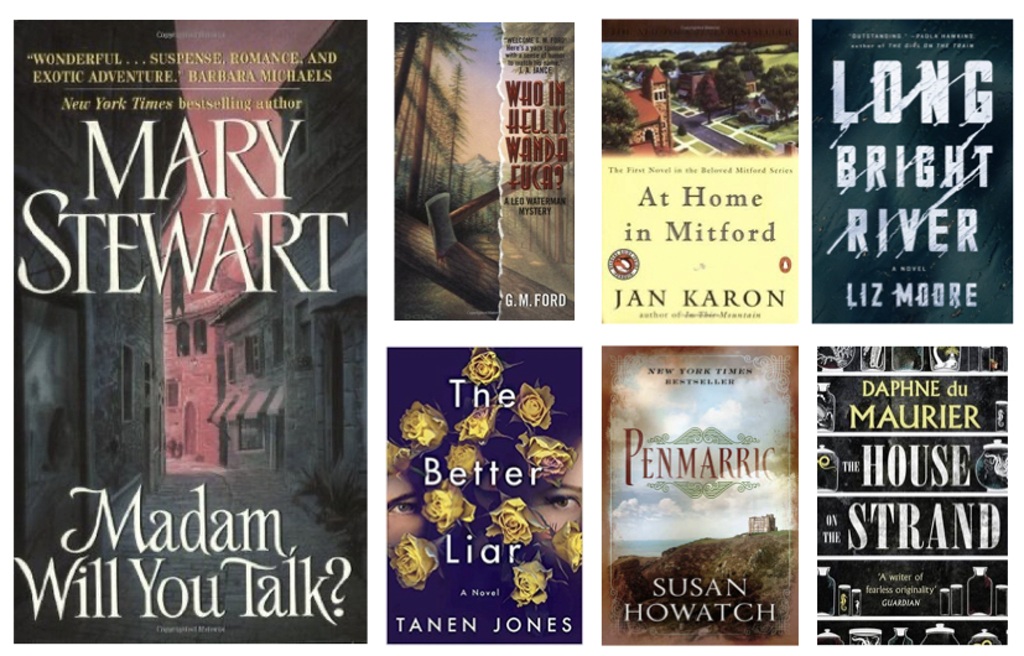It’s time for another adventure in Kate’s 6 Degrees of Separation Meme from her blog, Books Are My Favourite and Best. We are given a book to start with, and from there we free associate six books.
This month is a wild card: We are to start with the book we’ve ended a previous chain with, and continue from there.
I’ve decided to start with the final book from a 6 Degrees of Separation post I did over the summer: Madam, Will You Talk? by Mary Stewart.
1. Another novel with a title ending with a question mark is Who in Hell is Wanda Fuca? by G.M. Ford. This is the first book in Ford’s Leo Waterman series set in Seattle. Waterman is a P.I. who often enlists his homeless buddies to gather intel for him. They’re the best sleuths because people mostly just ignore street people.
Side Note: I have a database that contains all the books I’ve read since (and including) 1991. That’s more than 1,750 books, and I was surprised to find that only six titles end with a question mark. I’m sure there’s an interesting story in that fact, but I’ll save it for another time.
2. Whenever I come across homeless people in a novel, I remember how incensed I was with Jan Karon’s portrayal of them in her 1994 novel At Home in Mitford. The homeless people very considerately set up camp in a secluded area far from the center of town and only very occasionally come into town to Dumpster dive for something to eat. The town’s residents therefore don’t have to see them (some residents are even surprised to hear about the existence of the homeless) and acknowledge that life in Mitford is not idyllic for everyone.
3. Liz Moore’s recent novel Long Bright River offers a more credible picture of society’s impoverished citizens. Set in present-day Philadelphia, the book centers around two sisters, Mickey, a police officer, and Kacey, an addict living on the street. Mickey has had chances for promotion but prefers to keep covering her regular beat so she can keep an eye on her sister as well as the other addicts she has gotten to know. While other police officers have become hardened over the lives and deaths of these people, Mickey always treats them with respect. (This is the best novel I’ve read this year. I highly recommend it.)
4. A different dynamic binds the two sisters in The Better Liar by Tanen Jones. Leslie hasn’t seen her younger sister, Robin, since Robin left home 10 years ago, at age 16. But when the women’s father’s will stipulates that both women must show up, together, at his lawyer’s office to receive their inheritance, Leslie—who really needs the money—goes in search of her sister.
5. Family inheritances can often get messy, as evidenced in Penmarric, Susan Howatch’s intergenerational saga about a family estate on the coast of Cornwall. Widowed grandmothers and mothers, spinster sisters, and illegitimate sons don’t fare well in a system that favors the oldest son.
6. An old family house in Cornwell also provides the setting for Daphne du Maurier’s novel The House on the Strand. When Dick Young’s friend Magnus lends him the house for the summer, Dick agrees to be a test subject for a new drug Magnus is developing. The drug sends Dick back 300 years, to possibilities he finds more enticing than his present life.
And so have we have traveled from a question mark in the present to questionable possibilities in the past, and from Seattle to Cornwall, with lots of human drama in between.
© 2020 by Mary Daniels Brown


What an interesting selection, Mary. I can’t call to mind anything I’ve read that has homeless people central to the story. Long Bright River appeals to me. At Home in Mitford sounds bad. I need to read more du Maurier – I have Jamaica Inn on my pile of books. I might have to seek out The House on the Strand, as your description has turned my preconception of du Maurier on its head!
Yes, Jan, The House on the Strand also intrigued me as being fundamentally different from du Maurier’s other works. And yes again, At Home in Mitford is pretty bad. Thanks for reading and commenting.
Nice… I’m sure I read Penmarric a long time ago.